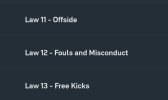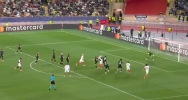I am not hiding anything. My error was in confusing the numbering of the laws, not in the meaning of the content of the laws.
Nice try. That's not what i was referencing when i said you hid your answer in the rewrite. I highlighted what i wass talking about. You pretending 'fouls' only involved direct kicks.
The laws talk about fouls and misconduct. One of the seventeen laws actually has Fouls and Misconduct as its title (Law 12). If you read the laws, you will agree with me that when they mention fouls, they mean offences involving physical contact by one player against another. Other law contraventions that do not involve physical contact between two players generally fall under the Misconduct category of offences.
Wrong. Intuitively this is obvious. A handball for example doesn't involve contact with another player. Yet its a foul. And a direct kick for that matter.
Let me clear things up for you..
A foul (foul play) occurs when one team gains an advantage by breaking one of the rules of the game. A foul play can only occur when the ball is in play. Can only be committed by a player in the game. and against a player from the opposing team. Except for ball handling, which is deemed to be committed against the opposing team as a whole. And a foul can only take place on the field of play.
Fouls are divided into 2 categories: Those for which
Direct kicks are awarded and those for which indirect kicks are awarded.
Misconduct:
A misconduct is
ANY action which brings the game into disrepute.
There are 2 categories :
The first category
are fouls which through the violent or unsporting nature of them, a free kick is not sufficient as discipline (i.e a yellow or red card Is required as a second punishment for the misconduct). The second, are unsporting actions that do not fit the criteria of being a foul.(i.e. Bernardo mouthing off to the ref and getting a yellow is a 'non foul' misconduct.)
Conclusion, some fouls are also misconducts, but not all misconducts are fouls. Fouls are about advantage gaining illegal actions that occur during play. Misconduct are about actions that bring the game into disrepute. Whether in play or not.
Hopefully that helps your understanding.
It seems to me that you have a different interpretation of the word "foul" - one which includes non-contact offences as fouls, when they should be referred to as misconduct.
Not a different interpretation, a more complete understanding.
Your arguments are incompatible with the laws as highlighted below. Using quotes from the Laws of the Game, please show me where it says or implies that "a raised boot, even without contact, is a foul".
View attachment 171202
Lol. Easy. The foul of playing in a dangerous manner punishable by an indirect free kick.
Again
"
Direct and indirect free kicks and penalty kicks can only be awarded for offences committed when the ball is in play."
The bolded is from the beginning section of the Law you've been quoting from. Hopefully, this clears it up for you.



